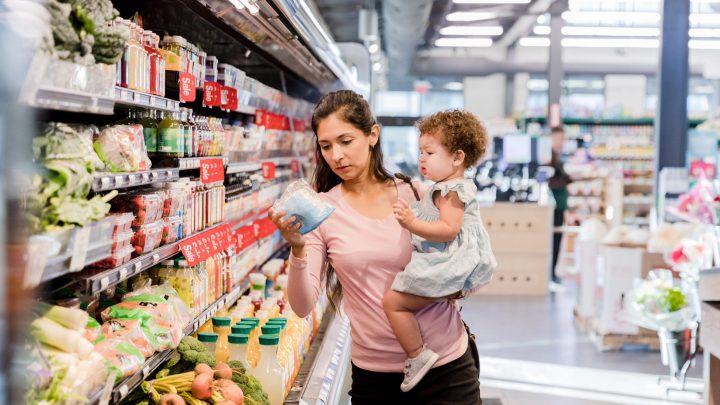
The WIC family food program is getting a refresh, but requirements are still tough to navigate
The WIC family food program is getting a refresh, but requirements are still tough to navigate

Every month, the Stone family in Spring Arbor, Michigan, is faced with a challenge: How to use seven gallons of low-fat milk? Mom Annie Stone says that’s a lot to get through, even with a baby, a toddler and a first-grader in the mix. She prefers to give her growing kids full-fat dairy.
“Who really wants skim milk? I don’t know anybody who drinks skim milk,” said Stone.
But that’s what the Special Supplemental Nutrition Program for Women, Infants and Children, better known as WIC, prescribes because skim milk has less saturated fat. So, Stone pays out of pocket for her family’s preferred dairy and gets creative with the WIC-alloted stuff.
“I have been making yogurt with it, but you have to add heavy cream to it. We get that from a local farm,” said Stone. She also uses the low-fat milk in pasta sauces and to make desserts.
Stone, who takes care of her kids full time, and her husband, a middle-school English teacher, have been using WIC for seven years since their eldest was a baby.
“It’s not a ton of money, especially in the economy we’re living in. Grocery bills are just insane right now. But it’s something,” she said, and it takes the edge off the family’s monthly grocery bill.
Stone is grateful for the help. She recommends the program to friends, but warns them that their new shopping list will come with a learning curve.
“So for example,” Stone said, reading from her own list of WIC-approved purchases. “Seventy-two ounces of cereal. So it’s not by boxes. It’s by ounces.”
And you know who doesn’t have time to do math at the grocery store? Parents of little kids.
Stone has mostly memorized the specific amounts of food she can buy with her WIC card. “But the first few times you go, if you haven’t done it before, it can be pretty daunting,” she said.
Even after seven years, “every time I go to checkout, I, like, cross my fingers and hope, like, ‘Oh, I hope that’s still applicable.’”
Soon, Stone’s shopping list will be a bit more expansive. For the first time in 10 years, the U.S. Department of Agriculture has approved updates to the WIC program’s food package. WIC users will have a larger allowance to spend on fruits and vegetables at their discretion and expanded options for whole grains, dairy and dairy substitutes to account for cultural preferences and allergies.
The WIC program serves eligible low-income pregnant and postpartum parents, infants and kids up to age 5. It’s restrictive by design, said Parke Wilde, a professor of food and nutrition policy at Tufts University.
“WIC grew out of a sense in the 1970s that pregnant women and postpartum women had particular nutritional deficiencies that couldn’t be remedied by prescribing a pharmaceutical. It really required prescribing food,” Wilde said, adding there’s evidence that approach works to promote outcomes like healthy pregnancies and infant birth weights.
“That’s one of the most poignant health outcomes you could mention,” Wilde said.
But for any food aid program, Wilde said restrictions to promote nutrition come with costs.
“It could add to the stigma associated with program participation,” Wilde said, and users might fear becoming the center of attention in the grocery line if their benefit card declines a purchase. “Or it could make the program less appealing to the clients, causing them not to participate in the first place.”
About half of eligible families participate in WIC. Participation drops to as low as a quarter when kids are too old to qualify for infant formula. That’s when parents start having to navigate that hyperspecific grocery list and when kids start to have opinions about what’s in the cart.
In 2020, more than 80% of eligible households took advantage of the much more flexible benefits offered by the Supplemental Nutrition Assistance Program or SNAP.
“The program keeps getting bigger and bigger,” said Angela Rachidi, who researches food aid at the American Enterprise Institute.
In the last five years, Rachidi said, the pandemic and inflation have helped drive up enrollment and government spending on SNAP. She said some lawmakers and public health advocates want to leverage the growing program to promote better nutrition.
“If you’re going to increase benefits, then you should also place expectations on what people are going to purchase with those funds,” said Rachidi.
Rachidi hopes to see funding in the upcoming farm bill for pilot programs to test various tools: from targeted bans on items like sugary soda to a WIC-inspired, specific food package for SNAP users. Not everyone is sold on that approach.
“I think it’s overly simplistic to think that restrictions will really move the needle on healthy eating,” said Diane Whitmore Schanzenbach, an economist at Northwestern University.
She said a lot goes into food purchasing choices, including cultural preferences, allergies, how much time work schedules allow for cooking meals and whether you’re feeding picky eaters.
“I’ve got three kids, and the number of dinners that all three of them like is a narrow set,” said Whitmore Schanzenbach.
She favors financial incentives for buying healthier with nutrition benefits like SNAP, though those proposals tend to add to program costs.
Annie Stone, the Michigan mom of three, said the most useful part of her WIC allowance will increase when the USDA’s changes go into effect: the $70 a month she gets to spend on fruits and vegetables with no other restrictions.
“I love that part of the program. The ease of navigating that money is awesome,” Stone said.
Because she can choose the foods she knows her family will actually eat.
There’s a lot happening in the world. Through it all, Marketplace is here for you.
You rely on Marketplace to break down the world’s events and tell you how it affects you in a fact-based, approachable way. We rely on your financial support to keep making that possible.
Your donation today powers the independent journalism that you rely on. For just $5/month, you can help sustain Marketplace so we can keep reporting on the things that matter to you.

















